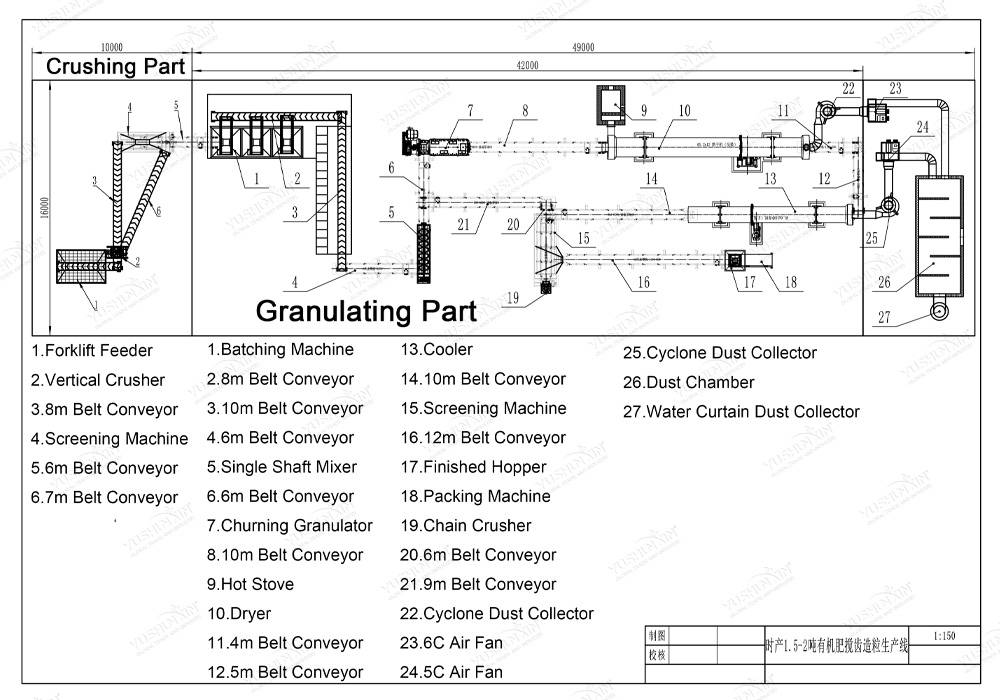







Untuk menukar batu fosfat menjadi bentuk baja yang boleh digunakan, Asid diperlukan “Fizzy” batu, yang mengeluarkan sebatian fosforus larut. Asid biasa yang digunakan termasuk:
Untuk membuat Baja NPK, Sumber lain nitrogen dan kalium boleh dicampur dengan bahan fosfat. Beberapa contoh termasuk:
Kos setiap barisan pengeluaran berbeza -beza bergantung kepada kapasiti pengeluaran, tahap automasi, dan keperluan khusus. Isi borang di bawah dan kami akan memberikan anda sebut harga yang tepat!
Sekiranya anda berminat dengan peralatan membuat baja kami, Sila hantar keperluan dan kenalan anda dan kemudian kami akan menghubungi anda dalam dua hari. Kami berjanji bahawa semua maklumat anda tidak akan dibocorkan kepada sesiapa.
- Syarikat itu ditubuhkan di 2005 dan telah memberi tumpuan kepada penyelidikan dan pembangunan dan pembuatan peralatan baja organik untuk 20 tahun. Ia telah membina asas pengeluaran peralatan baja organik berskala besar 40,000, Menggunakan granulasi lanjutan, teknologi pengeringan dan pemeriksaan untuk meningkatkan kecekapan pengeluaran dan kualiti produk.
- Syarikat import dan eksport yang dikendalikan sendiri dengan lebih daripada 80 Jurutera profesional di seluruh dunia, berkhidmat lebih daripada 100 negara dan kawasan di seluruh dunia, 5,000+ Kes perkhidmatan pelanggan, 10 pusat pemprosesan, 3 Mesin pemotongan laser, dan lebih daripada 60 Peralatan pelbagai jenis.
- Mengekalkan kerjasama jangka panjang dan luas dengan banyak institusi penyelidikan saintifik dan universiti, with a professional R&D team, Ia terus mengoptimumkan prestasi peralatan mengikut permintaan pasaran.
- Bahan tahan lama kekuatan, Karbon keluli Q235/aloi dipilih untuk memastikan peralatan itu tahan lama dan mengurangkan kos penyelenggaraan.
- Mengguna pakai sistem kawalan pintar untuk meningkatkan tahap automasi pengeluaran dan mengurangkan pergantungan manual.
- ISO, CE, Pensijilan SGS International
- Dengan kapasiti pengeluaran berskala besar, Ia dapat memenuhi keperluan kapasiti pengeluaran yang berbeza (kecil, garisan pengeluaran sederhana dan besar).
- Pelbagai model peralatan, Sesuai untuk pengeluaran pelbagai jenis baja seperti baja organik, Baja kompaun, baja biologi, baja larut air, baja cecair, dll.
- Reka bentuk yang diperibadikan dapat disediakan mengikut keperluan pelanggan, termasuk kapasiti pengeluaran, susun atur tapak, Piawaian perlindungan alam sekitar, dll.
- Sediakan satu set penyelesaian garis pengeluaran lengkap, termasuk pemilihan peralatan, pemasangan dan pentauliahan, Latihan Teknikal, dll.

- Bekalan kilang langsung, mengurangkan pautan orang tengah, Dan harganya lebih kompetitif.
- Peralatan mempunyai kecekapan tenaga yang tinggi, mengurangkan penggunaan tenaga, dan membantu pelanggan mengurangkan kos operasi jangka panjang.
- Bekalan kilang langsung, mengurangkan pautan orang tengah, Dan harganya lebih kompetitif.
- Peralatan mempunyai kecekapan tenaga yang tinggi, mengurangkan penggunaan tenaga, dan membantu pelanggan mengurangkan kos operasi jangka panjang.
Membekalkan mesin penggilap baja ke pengeluar baja terkemuka di Belanda
Penghantaran Granulator Double-Roller 1T/H kepada Pelanggan di Turki dan UK
Penyelesaian Kompos Kompos yang cekap dihantar kepada pelanggan Filipina
Penghantaran granulator cakera yang berjaya kepada pelanggan Chile untuk pengeluaran baja
Meningkatkan kecekapan pelletizing untuk kumpulan goodearth, Afrika Selatan